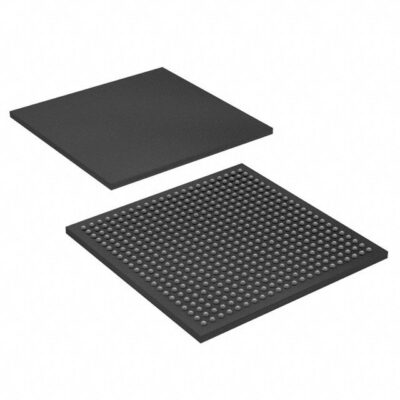XC6SLX75-3CSG484I
Part Number: XC6SLX75-3CSG484I
Manufacturer: AMD
Description: IC FPGA 328 I/O 484CSBGA
Shipped from: Shenzhen/HK Warehouse
Stock Available: Check with us
ICRFQ.com - Electronic Components Distributor in China Since 2003

Part Number: XC6SLX75-3CSG484I
Manufacturer: AMD
Description: IC FPGA 328 I/O 484CSBGA
Shipped from: Shenzhen/HK Warehouse
Stock Available: Check with us
| Datasheet | |
|---|---|
| Category | Integrated Circuits (ICs) |
| Family | Embedded – FPGAs (Field Programmable Gate Array) |
| Manufacturer | Xilinx Inc. |
| Series | Spartan? 6 LX |
| Part Status | Active |
| Number of LABs/CLBs | 5831 |
| Number of Logic Elements/Cells | 74637 |
| Total RAM Bits | 3170304 |
| Number of I/O | 328 |
| Number of Gates | – |
| Voltage – Supply | 1.14 V ~ 1.26 V |
| Mounting Type | Surface Mount |
| Operating Temperature | -40°C ~ 100°C (TJ) |
| Package / Case | 484-FBGA, CSPBGA |
| Supplier Device Package | 484-CSPBGA (19×19) |
Field-Programmable Gate Arrays (FPGAs) are unsung heroes in today’s fast expanding technological scene. These adaptable devices power our digital world while remaining silent. In this investigation, we will concentrate on one standout: the XC6SLX75-3CSG484I Spartan-6 FPGA. It’s more than a chip; it’s a driving force for innovation in our networked world. Join us as we explore its potential and uses.
In the realm of Field-Programmable Gate Arrays, the Spartan-6 FPGA series represents the pinnacle of versatility and performance. Spartan-6 FPGAs are a valuable instrument in today’s technological arsenal due to their versatility and raw power.
These gadgets excel at transforming and adapting to a wide range of applications. Spartan-6 FPGAs are the go-to choice for engineers looking for a dynamic and dependable solution, whether it’s serving as the brains behind cutting-edge telecommunications equipment, increasing industrial automation systems, or enhancing aerospace and defense solutions.
The many speed grades available are at the heart of its attractiveness, with the -3 grade being the pinnacle of performance. This ensures that Spartan-6 FPGAs can handle difficult jobs at unrivaled speed and efficiency. This FPGA series combines versatility and power to foster innovation across industries.
The Spartan-6 FPGA series, which includes the XC6SLX75-3CSG484I, comes in a variety of speed grades, with -3 being the highest performance grade. When choosing an FPGA, speed ratings are critical because they influence the device’s maximum clock frequency and overall performance capabilities. As a -3 speed grade FPGA, the XC6SLX75-3CSG484I provides top-tier performance, making it suited for applications requiring high-speed data processing and signal handling.
The Spartan-6 LX FPGA is a member of Xilinx’s Spartan-6 FPGA family, which is recognized for its low power consumption and great performance. Its design consists of configurable logic blocks (CLBs), digital clock managers (DCMs), memory blocks, and I/O resources. Here’s a rundown of its architecture:
Understanding the Spartan-6 LX FPGA’s core features and components is critical for efficiently building and executing FPGA-based solutions tailored to your individual application requirements.
Spartan-6 FPGAs are designed to function in a variety of temperature ranges, including commercial (C), industrial (I), and expanded (Q). Because it is an industrial-grade device, the XC6SLX75-3CSG484I can endure the rigors of industrial environments, making it suited for applications requiring strong performance at variable temperatures. It’s vital to remember that various speed grades and devices may be available at different temperatures for distinct purposes, such as automotive and military.
The XC6SLX75-3CSG484I is distinguished by its identification as a -3N speed grade FPGA, suggesting that it does not provide MCB (Memory Controller Block) capabilities. MCBs are required for interfacing with external memory devices and are commonly used in FPGAs built for applications that need intensive memory operations. While it does not support MCBs, the XC6SLX75-3CSG484I excels in other areas of FPGA performance, making it ideal for jobs that prioritize computation and signal processing over large memory operations.
The XC6SLX75-3CSG484I Spartan-6 LX FPGA IC is an essential component in electronics, with applications ranging from telecommunications to aerospace. Discover FPGA development, where boundless creativity abounds, regardless of your degree of experience. FPGA technology provides a thrilling tour into the future of electronics. Participate in the ever-changing FPGA scene today. Connect with ICRFQ, your reliable electronic component partner, to realize the full potential of the XC6SLX75-3CSG484I in your designs.
WhatsApp us